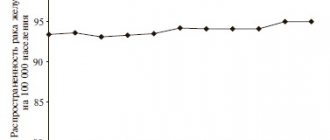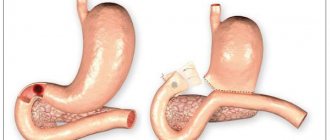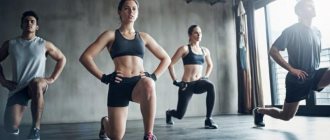For gastrointestinal diseases that are not associated with infection in the body, physical therapy (physical therapy) is used as an auxiliary method of treatment. It is necessary, first of all, for general stimulation of the body. Exercise therapy also activates recovery processes in the body, as it enhances lymph and blood supply to the abdominal organs.
Exercise therapy normalizes the secretion and motor function of the gastrointestinal tract in adults and children. At the acute stage, physical therapy is also recommended, which relieves pain and calms.
With hypoacid gastritis, an increase in secretory function is achieved through physical therapy 1.5-2 hours before or after a meal. Emotionally intense exercises and a moderate level of stress are used.
With hyperacid gastritis, it reduces secretory function:
- physical therapy a few minutes before meals and immediately after meals
- monotonous nature of the exercises
- slow execution theme.
If pain syndrome is severe due to gastrointestinal diseases, it is better to avoid exercises for the abdominal muscles.
Therapeutic exercises (physical therapy) for gastritis and peptic ulcers
1. Lie on your back. Breathe rhythmically, taking medium inhalations and exhalations 2-3 times (inhale on a count of 1-2-3 and exhale on a count of 4-5-6-7). Next, breathe randomly 6-8 times.
2. Bend and extend your ankles 6-8 times.
3. Next, under a rhythmic count, bend your elbows, straighten them forward, bend your elbows again and take the starting position. The exercise must be repeated 5-7 times.
4. Next exercise: alternately bend your legs at the knee and hip joint, while your feet slide along the bed. Repeat 3-4 times with each leg.
5. Bend your fingers into fists. Breathe randomly 8-10 times.
6. Starting position - lying on your back, legs bent at the knees, feet resting on the bed. Spread and contract your knees 4-5 times.
7. From the starting position (see point 6), lift your pelvis. Support is on the back of the head, arms and feet. Inhale – starting position – exhale. Repeated 4-5 times.
8. Breathe rhythmically 2-3 times. Inhale for a count of 1-2-3 and exhale for a count of 4-5-6-7.
9. From the position lying on your back, turn onto your right side and move to a sitting position (legs down). Repeat 5-6 times.
10. We start sitting. Chest breathing, medium depth, repeat 2-3 times.
11. Place your hands on your shoulders – inhale. Lower back - exhale. Repeat 5-6 times.
12. We start standing. Take turns bending your knees 3-4 times.
13. Start lying on your back. The legs are slightly apart, the muscles are relaxed. We breathe randomly for 5-6 seconds.
14. Take turns moving your legs to the sides (sliding along the surface of the bed). Repeat 3-4 times with each leg. We breathe arbitrarily, as you feel comfortable.
15. Under a rhythmic count, turn your hands palms up, while spreading your feet. Then we take the starting position (lying on your back). We complete the complex with breathing of medium depth (2-3 inhalations and exhalations).
Exercises for diseases of the digestive system
Diseases of the digestive system include gastritis, cholecystitis, gastric ulcer and others. Physical exercises help normalize the motor and secretory functions of the gastrointestinal tract and activate blood circulation in the abdominal cavity. Special exercises help strengthen the abdominal muscles, especially the anterior abdominal wall. They must be performed from various starting positions, but most often in a sitting position and lying on the back. These exercises should alternate with general developmental and breathing exercises. They should be performed calmly, with moderate muscle tension.
A set of exercises for diseases of the digestive system
1. I.p. - lying on your back. Hand movements: to the shoulders - to the sides - to the shoulders - down.
2. I.p. – lying on your back, one hand on your stomach. Inhale, raising the abdominal wall, then lowering it - exhale.
3. I.p. - lying on your back. Alternately bend your legs at the knee joint, sliding your heels along the floor.
4. I.p. – lying on your back, legs bent. Extension and abduction of the hips.
5. I.p. - lying on your back. Alternately raising straight legs.
6. I.p. - Same. Alternately moving your legs to the sides.
7. I.p. - Same. Raising your head and shoulders, arms forward; return to IP - inhale.
8.I.p. - Same. Bend your legs and press them to your chest with your hands. The same thing but without using your hands.
9. I.p. - Same. Bend the right one, straightening it forward and lower it into an i.p. The same with the left leg.
10.I.p. - Same. Raise the right one, move it to the right, bring it up and lower it into the i.p. Same with the left.
11.I.p. - Same. Simulation of cycling.
12.I.p. - Same. Sliding along the floor, bend your legs, lift them, bend them forward and lower them into an i.p.
13.I.p. - Same. Using your hands, sit down and return to standing position.
14.I.p. – lying on your back, arms to the sides. Raise your legs, spread them, lower them, lift them, connect them and lower them into an i.p.
15.I.p. - Same. Raise your legs forward, hold the pose for 4-6 seconds and lower.
16.I.p. - Same. Raise your legs, perform 4-5 scissor movements and lower.
17.I.p. - lying on your back. Sit with a forward bend, sliding your hands along your legs, return to the standing position.
18.I.p. – sitting, hands to shoulders, elbows forward. Alternate leg bends until the opposite hand touches.
19.I.p. – sitting, legs secured to the rail. Lean back and return to i.p. The same hands behind the head.
20.I.p. – lying on your back, legs slightly bent and spread apart. Alternately lowering the legs to the right, then to the left.
21.I.p. – emphasis while standing on all fours. Sit on your heels and lean forward.
22.I.p. – gray hair on the heels. Raise your arms, bend over - inhale. Return to i.p. - exhale.
23.I.p. - lying on your back. Deep breathing, eyes closed, muscles relaxed.
24.Walking with changes in pace. Breathing is voluntary.
A set of exercises to strengthen the anterior abdominal wall
1. I.p. – lying on your back, one hand on your stomach. Inhale, raising the abdominal wall, then lowering it - exhale.
2. I.p. - Same. Inhale and, without exhaling, push out and draw in the abdominal wall
3. I.p. - Same. Raising your head and shoulders, arms forward; return to IP
4. I.p. – lying on your back, hands behind your head. Raise your head and shoulders, then return to the standing position.
5. I.p. - lying on your back. Bend your legs and press them to your chest with your hands. The same thing but without using your hands.
6. I.p. - Same. Spreading and bringing your legs together on the floor. The same lifting.
7. I.p. – lying on your back, right one bent. Alternate flexion and extension of the legs.
8. I.p. - lying on your back. Bend your legs, straighten them forward, bend them and lower them into an i.p.
9. I.p. - Same. Raising and lowering straight legs.
10.I.p. - Same. Raise your legs, perform 4-5 scissor movements and lower.
11.I.p. – lying on your back, arms to the sides. Raise your legs, spread them, lower them, lift them, connect them and lower them into an i.p.
12.I.p. – emphasis while sitting at an angle. Cross horizontal scissor leg movements.
13.I.p. – lying on your back, legs raised. Simulation of cycling.
14.I.p. – gray legs apart. Springy forward bends.
15.I.p. - lying on your back. Stand on shoulder blades (“birch”).
16.I.p. - Same. Raise your legs and touch your toes behind your head.
17.I.p. - Same. Perform the previous exercises, but lower your legs to sit down, then lie down.
18.I.p. – sitting, legs secured to the rail. Lean back and return to i.p. The same hands behind the head.
When performing exercises, people with high myopia should take into account that long and strenuous transitions from a sitting position to a lying position and back are undesirable for them.
A set of exercises for chronic gastritis (according to M.A. Korkhin)
1. I.p. - lying on your back. Raising and lowering hands. Breathing is uniform.
2. I.p. - Same. Simultaneously raising your arms up and spreading your legs apart. The pace is slow. Breathing is uniform.
3. I.p. - Same. Alternately raising your arms up. The pace is average.
4. I.p. - Same. Alternate leg bends to chest. The pace is slow. Do not hold your breath.
5. I.p. – lying on your back, legs half bent. Bend over using your hands and feet. The pace is slow. Breathing is uniform.
6. I.p. - Same. Alternately turn your legs to the sides (do not lift your shoulders and the back of your head off the floor). The pace is slow.
7. I.p. - lying on your back. Alternating straight leg raises. The pace is slow.
8. I.p. - Same. Alternately bending and extending the legs in a circular motion (“bicycle”). The pace is average. Breathing is uniform.
9. I.p. - lying on your right side, right hand behind your head, left hand in front of you. Flexion and extension of the left leg. Repeat the same while lying on your left side.
10. I.p. - Same. Simultaneous abduction of the left leg and arm to the side. The pace is slow. Repeat the same while lying on your left side.
11. I.p. – emphasis while standing bent over. Alternately moving the legs back. The pace is slow, do not hold your breath.
12.I.p. – o.s. (inhale). Squats. The pace is slow.
13.I.p. – stand, arms up (inhale). Springy bends (exhale). The pace is average.
14.I.p. - standing, supported by a chair. Squats. Breathing is uniform.
15.I.p. – standing, sideways to the support. Swing your right hand forward. Repeat the same with the left. The pace is average.
16.I.p. – stand, arms up. Circular movements with your arms forward. Breathing is uniform.
For gastritis with low acidity, atony of the stomach and intestines, prolapse of the abdominal viscera, moderate physical activity that does not cause fatigue increases metabolism, improves blood circulation and stimulates the activity of all organs. Under the influence of physical exercise, the secretion of digestive juices increases. Along with exercises for all muscle groups, exercises with heavy load on the abdominal muscles are widely used. For constipation, which very often accompanies atony, you should perform additional exercises associated with shaking the body (jumping rope, sports games, skiing and rowing).
A set of exercises for chronic gastritis with normal and high acidity
1. Walking in combination with breathing: inhale for 2 steps, exhale for 3-5 steps.
2. I.p. – stand, arms forward. Retraction of arms to the sides, behind the head - inhale, to the sides and in the i.p. - exhale. 4-6 times.
3. I.p. – sitting on a chair, hands in front of the chest. Alternately rotate the torso to the sides, arms to the sides - inhale, returning to the i.p. - exhale. 4-6 times in each direction.
4. I.p. - sitting on a chair. Alternate bends to the sides, one hand slides down the leg, the other up, to the armpit, 4-6 times.
5. I.p. - sitting on the edge of a chair. Alternating straight leg raises. 4-6 times with each leg.
6. I.p. – lying on your back, legs bent, hands to your shoulders. At the same time, straighten your legs without lifting them from the floor and raise your arms up - inhale, return to the i.p. - exhale. 4-6 times.
7. I.p. – emphasis while standing on all fours. Simultaneously raising the right leg back and left arm up. Return to i.p. Repeat the same with the other leg and arm. 6-8 times.
8. I.p. - Same. Push off with your hands and sit on your heels – inhale. I.p. - exhale. Perform the exercise without the participation of the abdominal muscles. 4-6 times.
I.p. - sitting on a chair, one hand on your stomach, the other on your chest. Full diaphragmatic-thoracic breathing. 4-6 times.
A set of exercises for chronic gastritis with high acidity
1. Walking in place with a high hip lift. 15 sec.
2. I.p. – o.s. Alternately moving your legs back onto your toes, arms up – inhale. I.p. - exhale. 3-4 times.
3. I.p. – stand with your legs apart, hands in front of your chest. Alternate turns of the torso, arms to the sides - inhale. I.p. - exhale. 4-6 times.
4. I.p. – narrow stance with legs apart. Alternate bends to the sides, one hand slides down the leg, the other up, to the armpit. 4-6 times.
5. I.p. – stand with your legs apart, hands up in the “lock”. Bend forward – “lumberjack”. 6-8 times.
6. Full breathing.
7. I.p. - lying on your back. Bending the right one, pull it to the chest with your hands - exhale, return to the i.p. - inhale. Repeat the same with the left. 4-6 times with each leg.
8. I.p. - Same. Alternating straight leg raises. 4-6 times each.
I.p. - lying on your back, one hand on your stomach, the other on your chest. Full diaphragmatic-thoracic breathing. 4-6 times.
Calming walking 1-1.5 minutes: 2-3 steps - inhale, 3-5 steps - exhale.
In patients with increased secretion, the load should be significantly greater - at the level of submaximal work power, but the number of exercises for the abdominal muscles should be limited and performed with moderate power. When combining dietary nutrition, drinking mineral water and physical therapy, it is most advisable to drink mineral water before physical education, and eat food 15-20 minutes after exercise.
A set of exercises for gastritis with reduced secretion
- I.p. – o.s. Alternately moving your legs back onto your toes, arms up – inhale. The pace is slow.
- I.p. – stand with legs apart. Alternate turns of the torso, arms to the sides - inhale. The pace is slow.
- I.p. – stand with your legs apart, hands behind your head. Alternate bends to the side. Breathing is uniform. The pace is slow.
- I.p. – stand with legs apart, arms up in a “lock.” Exercise “lumberjack.” The pace is fast.
- Full breath. The tempo is slow
- I.p. - lying on your back. Alternating straight leg raises. The pace is slow.
- I.p. - Same. Exercise "bicycle". Breathing is uniform. The pace is average.
- I.p. – lying position. Flexion and extension of the arms in support. The pace is average.
- I.p. – stand, hands to shoulders. Exhale squats, arms forward. The pace is average.
- I.p. – stand, arms to the sides. Raise your leg forward, take it back. The pace is average. Perform with each leg.
- I.p. – sit down, securing your legs to a rail (any object). Bend back - exhale. The pace is slow.
- Full breath. The pace is slow.
- I.p. – emphasis while standing on all fours. Simultaneously raising the left leg back, right arm up - inhale. I.p. - exhale. The same with the other leg. The pace is slow.
- I.p. - standing. Jumping with transition to walking. Breathing is uniform.
- Full breath. The tempo is slow
For gastritis with reduced secretion, you should drink mineral water after physical exercise, 15-20 minutes before meals.
Exercises for stomach ulcers
Complex No. 1 (lightweight)
1. I.p. – lying on your back, arms up. Bend your legs, feet slide along the floor, hands to your shoulders - exhale. Return to i.p. - inhale. 4-8 times.
2. I.p. – lying on the right side, the left one bent forward, the right arm under the head. Extending the left one back, left arm up – inhale, etc. - exhale. 4-8 times on each side.
3. I.p. - lying on your back. Alternately raising straight legs forward.
6-8 times.
4. I.p. - lying on your back, one hand on your stomach, the other on your chest. Full breathing through the nose. 4-8 times.
5. I.p. – standing on your knees (on all fours). Alternately raising the arm forward, the opposite leg back. 4-8 times with each hand and foot.
6. I.p. – sitting on a chair, hands in front of the chest. Turn the torso to the sides, arms to the sides, palms up. 4-8 times.
7. I.p. – sitting on a chair, arms forward. Clenching and unclenching the fingers while simultaneously flexing and extending the feet. 8-10 times.
8. I.p. - sitting with support on the edge of a chair. Alternately raising and moving the leg to the side. 6-10 times with each leg.
9. I.p. – sitting on a chair, stick up horizontally. Bend forward until the stick touches your feet alternately. 4-8 times to each leg.
10.I.p. - sitting on a chair. Alternately bending your legs to your chest, arms to your shoulders. 4-6 times with each leg.
11.I.p. - sitting with support on the edge of a chair. Squats, supported by hands. 8-12 times.
12.I.p. – sitting, one hand on your stomach, the other on your chest. Full breathing through the nose. 4-8 times.
13.Walking in place with deep breathing: inhale for 2-3 steps, exhale for 3-4 steps. 1-3 minutes.
Complex No. 2 (medium)
1. I.p. – sitting on a chair, hands in front of the chest. Turn the torso to the sides, arms to the sides, palms up. 4-8 times
2. I.p. - sitting with support on the edge of a chair. Alternately raising and moving the leg to the side. 6-10 times with each leg.
3. I.p. - sitting on a chair. Alternately bending your legs to your chest, arms to your shoulders. 4-6 times with each leg.
4.I.p. - sitting with support on the edge of a chair. Squats, supported by hands.
8-12 times.
5. I.p. – sitting on a chair, hands clasped under the right thigh. Raising the hip with your hands and relaxing the swing of your lower leg and foot. 4-6 times with each leg.
6. I.p. – lying on your back, arms up. Bend your legs, feet slide along the floor, hands to your shoulders - exhale. Return to i.p. - inhale. 4-8 times.
7. I.p. – lying on the right side, the left one bent forward, the right arm under the head. Extending the left one back, left arm up – inhale, etc. - exhale. 4-8 times on each side.
8. I.p. - lying on your back. Alternately raising straight legs forward.
6-8 times.
9. I.p. - lying on your back. Alternately bending the legs at the knee joints.
8-12 times.
11.I.p. – standing on your knees (on all fours). Alternately raising the arm forward, the opposite leg back. 4-8 times with each hand and foot.
12.I.p. – gray hair, arms to the sides. Bend forward until your hand touches the opposite foot. 8-12 times.
13.I.p. – sit on your heels, bend forward, arms up. Extending your legs and bending your arms in a “wave”, move to a position lying on your stomach, arms bent in support – exhale. Extending your arms and bending your legs, return to the i.p. – inhale 4-8 times.
14.I.p. – lying on your stomach, arms bent at rest. Bend, alternately moving your legs back. 4-6 times with each leg.
15.I.p. - lying on your back, one hand on your stomach, the other on your chest. Full breathing through the nose. 4-8 times.
16.Walking in place with deep breathing: inhale for 2-3 steps, exhale for 3-4 steps. 1-3 minutes.
17.I.p. – stand with legs apart, arms up. Consistent relaxation of the muscles of the arms, neck, torso and legs (squat). 3-4 times.
Complex No. 3 (reinforced)
1. I.p. – sitting on a chair, hands in front of the chest. Turn the torso to the sides, arms to the sides, palms up. 4-8 times.
2. I.p. - lying on your back. Alternately raising straight legs forward. 6-8 times.
3. I.p. - sitting on a chair. Alternately bending your legs to your chest, arms to your shoulders. 4-6 times with each leg.
4. I.p. - sitting with support on the edge of a chair. Squats, supported by hands.
8-12 times.
5. I.p. – sitting on a chair, hands clasped under the right thigh. Raising the hip with your hands and relaxing the swing of your lower leg and foot. 4-6 times with each leg.
6. I.p. – lying on your back, arms up. Bend your legs, feet slide along the floor, hands to your shoulders - exhale. Return to i.p. - inhale. 4-8 times.
7. I.p. - lying on your back. Alternately raising straight legs forward.
6-8 times.
8. I.p. – lying on the right side, the left one bent forward, the right arm under the head. Extending the left one back, left arm up – inhale, etc. - exhale. 4-8 times on each side.
9. I.p. - lying on your back. Alternately raising straight legs forward.
6-8 times.
10.I.p. – gray hair, arms to the sides. Bend forward until your hand touches the opposite foot. 8-12 times.
11.I.p. – sit on your heels, bend forward, arms up. Extending your legs and bending your arms in a “wave”, move to a position lying on your stomach, arms bent in support – exhale. Extending your arms and bending your legs, return to the i.p. - inhale.
4-8 times.
12.I.p. – sitting on a chair, hands clasped under the right thigh. Raising the hip with your hands and relaxing the swing of your lower leg and foot. 4-6 times with each leg.
13.I.p. – lying on your back, arms up. Bend your legs, feet slide along the floor, hands to your shoulders - exhale. Return to i.p. - inhale. 4-8 times.
14.I.p. – stand, stick below. Right back on the toe, stick up with a springing movement. Same with the left. 4-6 times with each leg.
15.I.p. – stand with legs apart, right hand forward, mouth into fist. Imitation of punches in boxing. 10-40 beats.
16.I.p. – rack, dumbbells below (weight 1-2kg). Lunge forward with the right, left hand up – inhale, return to IP. - exhale. The same with the left leg. 4-8 times.
17.I.p. – stand with legs apart, arms to the sides. Bend over, turning your torso to the left and touching your left foot with your right hand – exhale. I.p. - inhale. Repeat the same in the other direction. 4-8 times.
18.I.p. – standing facing the back of a chair with support from your hands. Squats 6-12 rubles.
19. Walking in place with deep breathing: inhale for 2-3 steps, exhale for 3-4 steps. 1-3 minutes.
20. I.p. – stand with legs apart, arms up. Consistent relaxation of the muscles of the arms, neck, torso and legs (squat). 3-4 times.
The load can be considered correct if after gymnastics you feel a surge of vivacity and energy. A feeling of fatigue and a desire to rest after exercise indicates an overdose of exercise. After exercise, the heart rate should not increase by more than 20 beats per minute, and after 5 minutes of rest, the heart rate should return to its original value or approach it.
A set of exercises for peptic ulcers of the stomach and duodenum (according to M.F. Grinenko)
1. I.p. – lying on your back, hands on your chest. Spread your arms to the sides - inhale, while exhaling, with your fingers spread as far apart as possible, press alternately on the lower and middle sections of the chest. 4-5 times.
2. I.p. - lying on your back. Raising your bent legs one by one, press your thigh to your chest with your hands. 4-5 times each.
3. I.p. – lying on your back, hands behind your head. After a deep breath, sit down, bend forward, touching your feet with your hands - exhale. Return to i.p. 4-6 times.
4. I.p. - Same. After a deep breath, lift the right one, move it to the side and slide along the floor to return to the I.P. Repeat the same with the left. 4-6 times.
5. I.p. – lying on your back, arms to the sides. Group, connect your elbows - exhale. I.p. - inhale. 7-8 times.
6. I.p. – lying on your back, legs bent, hands behind your head. Raise the pelvis up - inhale, return to the i.p. - exhale. 5-6 times.
7. I.p. – lying on your back, legs bent, knees apart. Lower your right knee to the left - exhale. Repeat the same with the other leg. 6-8 times.
8. I.p. - lying on your back. Simulation of cycling.
9. I.p. - Same. Raise your right leg and left arm at the same time – exhale. Return to i.p. - inhale. Repeat the same with the other leg and arm. 6-8 times.
10.I.p. – lying on your back, arms up. At the same time, sit down with your legs bent, clasp your knees with your hands - exhale, lie down in a standing position. - inhale. 4-6 times.
11.I.p. – lying on your right side, left hand on your waist. Bending the left one to the chest - exhale, return to the i.p. - inhale. 5-6 times.
12.I.p. - Same. At the same time, raise your left leg and arm to the sides - inhale, return to the i.p. - exhale. 5-6 times.
13.I.p. - Same. At the same time, left hand back, left hand forward - inhale, return to IP. - exhale. 5-6 times.
14-16. Repeat exercises 11-13 lying on your left side.
A set of exercises for gastric ulcers beyond the acute stage and gastritis with increased secretion
1. I.p. - sitting, hands on waist. Alternate turns of the torso to the side, arms to the sides - inhale. The pace is slow.
2. I.p. - sitting. Flexion and extension of the feet while squeezing and unclenching the hands. The pace is average. Breathing is uniform.
3. I.p. – sitting. Alternately raising straight legs - exhale. The pace is slow.
4. I.p. - sitting. Alternating tilts of the torso towards the right and left legs - exhale.
5. I.p. - sitting. Raise your knee to your chest, arms to your shoulders – exhale. The pace is slow.
6. I.p. – stand, hands to shoulders. Squats, arms forward - exhale. The pace is slow.
7. Alternately relax the muscles of the lower leg and foot. Breathing is uniform. I.p. – lying on your back, legs bent, hands on your chest in a lock. At the same time, straighten your legs without lifting them from the floor, raise your arms up, turn your palms up - inhale. The pace is slow.
8. I.p. - lying on your back. At the same time, turn on your side, move your leg back, arm up and bend over (inhale) and return to the I.P. - exhale. The pace is slow. The same on the other side.
9. I.p. – emphasis while standing on your knees. Simultaneously raising the left leg back, right arm up - inhale. I.p. - exhale. The same with the other leg. The pace is slow.
10.Walking with gradual slowdown. Breathing is uniform.
11.I.p. - sitting. Full, slow breathing under hand control.






